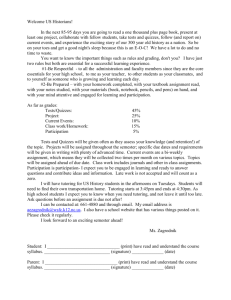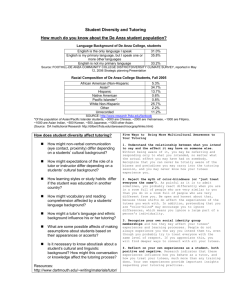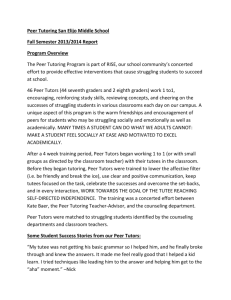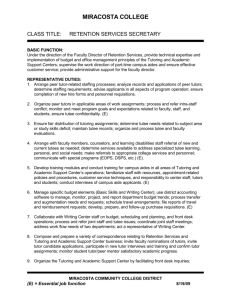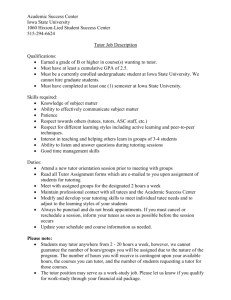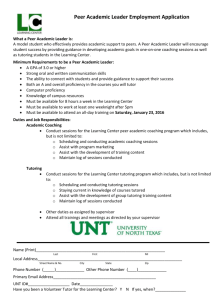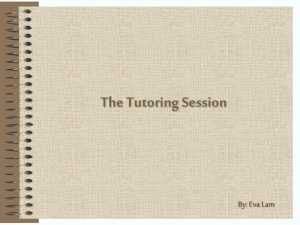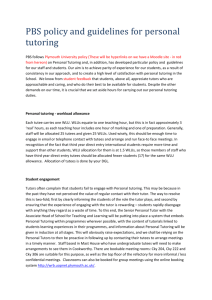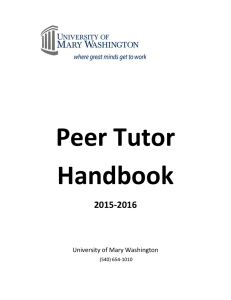Peer Tutor Training HO - Curriculum & Staff Development
advertisement
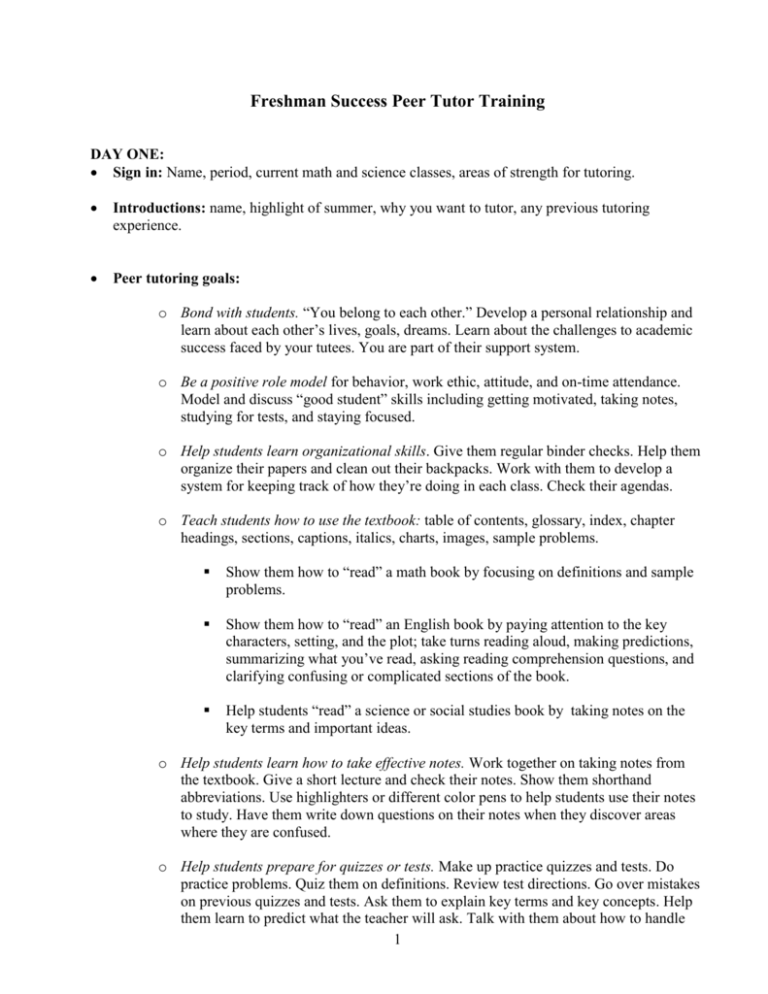
Freshman Success Peer Tutor Training DAY ONE: Sign in: Name, period, current math and science classes, areas of strength for tutoring. Introductions: name, highlight of summer, why you want to tutor, any previous tutoring experience. Peer tutoring goals: o Bond with students. “You belong to each other.” Develop a personal relationship and learn about each other’s lives, goals, dreams. Learn about the challenges to academic success faced by your tutees. You are part of their support system. o Be a positive role model for behavior, work ethic, attitude, and on-time attendance. Model and discuss “good student” skills including getting motivated, taking notes, studying for tests, and staying focused. o Help students learn organizational skills. Give them regular binder checks. Help them organize their papers and clean out their backpacks. Work with them to develop a system for keeping track of how they’re doing in each class. Check their agendas. o Teach students how to use the textbook: table of contents, glossary, index, chapter headings, sections, captions, italics, charts, images, sample problems. Show them how to “read” a math book by focusing on definitions and sample problems. Show them how to “read” an English book by paying attention to the key characters, setting, and the plot; take turns reading aloud, making predictions, summarizing what you’ve read, asking reading comprehension questions, and clarifying confusing or complicated sections of the book. Help students “read” a science or social studies book by taking notes on the key terms and important ideas. o Help students learn how to take effective notes. Work together on taking notes from the textbook. Give a short lecture and check their notes. Show them shorthand abbreviations. Use highlighters or different color pens to help students use their notes to study. Have them write down questions on their notes when they discover areas where they are confused. o Help students prepare for quizzes or tests. Make up practice quizzes and tests. Do practice problems. Quiz them on definitions. Review test directions. Go over mistakes on previous quizzes and tests. Ask them to explain key terms and key concepts. Help them learn to predict what the teacher will ask. Talk with them about how to handle 1 test anxiety (breathe!) and how to manage their time (make lists, plan schedule, prioritize.) o Show students how to study, reviewing homework and re-reading / highlighting their notes. Show them how to quiz themselves and how to write down questions to ask the teacher. Help them make and study from flashcards. Give them tips on how to memorize (mnemonics, images, using your own words). Focus on teaching key concepts and the process of learning, not just on getting the homework done. o Help students learn by “questioning” rather than by doing the work while they watch. Show them a sample problem and then give them a similar one, with different numbers. Have them think out loud. Ask them to “teach.” (Pretend you don’t understand.) o Coach students, e.g., how to study at home, how to work in a group, how to ask good questions in class, and how to talk with teachers when there’s a concern. Show them strategies for memorizing, taking notes, brainstorming essays, and preparing for tests. Motivate them to get back on track after missing class or getting a bad grade. Show them how to “psych” out the tests—figure out what is important to the teacher. Show them how teachers’ grading systems work. Help them become knowledgeable and skilled; don’t just focus on grades. o End each session by reflecting on what your group has don and, what the tutee has learned. Set goals for the next meeting. Tips about your relationship with the students: o Be a positive role model. o Encourage students to stay on task and to not disrupt others. o Help students learn how to study. o Be friendly and get to know each other as “friends.” o Ensure the students don’t feel dumb or “less than.” o Say hello in the hallways and out of class. You may want to meet tutees for lunch or in the library occasionally. You may want to go meet with the academic teacher and the tutee, during brunch, lunch, or after school. You may want your student to email you a draft of an essay for you to peer review. o Let the classroom teacher know if you’re ever confused about what to do, or if you’re ever uncomfortable, or if you have concerns about any students or the tutoring. o Note: As a tutor, you’re in charge. The classroom teacher is there to support you. Job expectations: 2 o Be on time and be prepared. Come in to the classroom ready to work with your tutees. Sign in as the classroom teacher directs you. o Teach “good student” habits through modeling, applying, and explaining them. Don’t be anxious about needing to know everything. o Help students stay focused and be productive during the entire tutorial. Especially at the beginning, don’t expect the student to initiate asking for help. Have a variety of responses when a student says, “I don’t have anything to do.” Ways to respond include checking their binders and backpacks, reviewing their agenda/assignments, reviewing class notes, looking over any quizzes or tests that have been passed back, and talking about how each class is going. This check-in should help you find a focus for each session. o Find out what gaps students have in their skills/knowledge and address them with specific exercises you devise or ask your classroom teacher about other resources. o Write a reflective journal on your tutoring experience each quarter, according to the directions the classroom teacher gives you. Getting started: o Sit in desks next to each other, looking on at the same text/papers (not across from each other). o Get acquainted and start bonding – exchange names, emails, phone numbers, find something you have in common – movie, music, sports. Begin each subsequent tutorial by continuing to develop your personal relationship with each tutee. o Begin your first session by determining the general focus of tutoring: Write down each tutee’s schedule – classes and teachers – and their quarter/semester grade goals. Discuss with tutees and make written notes as to where they’ll most likely need the most help – i.e., math/science; peer reviewing papers; note-taking; organization; studying for quizzes and tests; working on grammatical correctness in writing; staying focused, getting motivated, etc. Sample getting started / check-in conversations: o General: “What’s your favorite subject? Which class do you think will be hardest? What quarter grades do you want to earn in each class? What’s your game plan for reaching your grade goal for each class? How do you typically do 1st quarter?” 3 o Organization: “How have you organized your binder? Do you have any loose papers? Where do these papers in your backpack go? Do you have extra pens, pencils, erasers, highlighters? How do you use your agenda for keeping track of your assignments? How are you keeping track of your grades? Where do you study at home? What is the environment like? Since you were absent yesterday, what do you need to do to check in with each teacher and make up missing work?” o Note-taking: “Which classes do you take notes in? Show me. Which books do you take notes from? Show me. How do you organize your notes? How does STAR notetaking work for you? What abbreviations do you typically use? How do you keep your notes in order? How do you study your notes? Show me examples of where you have highlighted or re-worked your notes. Where do you keep track of questions you want to ask the teacher? Do you always understand what you’re taking notes on? Do you know why the teacher wants you to take notes?” o Math: “Where are your math lecture notes? Where is your assignment sheet? Where’s your quiz from last Friday? When is your unit test? Where’s the review test in your math book? What’s this example all about? Show me how to use this formula. How do you approach a math problem like this? Did you draw a diagram? Let’s go over that problem again, but this time you explain it to me.” Does your teacher allow you to do test corrections? o Science: “What kind of notes are you taking in science class? What kind of homework does your teacher expect you to do? When is your lab report due? Let me see it, so I can peer review it for you. Does your science book have a glossary? What are 3 things that confused you in this section? Why are these words bolded? Where are your flashcards? What kind of tests does Mr. X give? What grade did you get on the last test? How—specifically--did you study for that test? How much? When? What does ___ mean? Can you give me an example?” What didn’t you understand? o English: “What book are you reading in English? What confuses you? How do you keep track of characters’ names, and plot events? How do you keep track of key quotes you may want to use in your essay? What kind of reading assessments does your teacher give? Let’s take turns reading aloud and summarizing the story. Show me a passage you think is key. What do you think this symbol means? Where is the assignment sheet for your next paper/project? Shall we set aside time next week so I can peer review and help you edit your paper?” o SAT/PSAT/ACT prep: “When are you going to take the SAT/PSAT/ACT? Can I help you sign up online? What scores did you get last time you took it? Explain to me how the PSAT/SAT/ACT is scored and what the scores mean. Shall we work on this reading comprehension section separately and then compare and discuss our answers? Shall we work on these 5 math problems separately and then compare and discuss our answers? Shall we go over these sample analogies and then take this practice quiz? 4 When do you think it’s a good idea to guess on the SAT, and when do you think it’s not? Why? Where is your SAT test being held? What time are you supposed to be there? What are you supposed to bring?” o End each tutorial session by having tutees reflect on what you’ve been working on. Have them explain the concept clearly in their own words and give a relevant specific example. Set up goals for the following session, so both of you are prepared to begin work immediately during the next tutorial. Closing question: “What are your biggest concerns?” (We’ll address these tomorrow.) DAY TWO: Address concerns from Day One. Review handouts. Role play. Answer any questions. Close by asking tutors to each share an important idea that they’ve learned. THANK YOU SO MUCH FOR YOUR HELP! Helping other students truly makes a difference! 5

